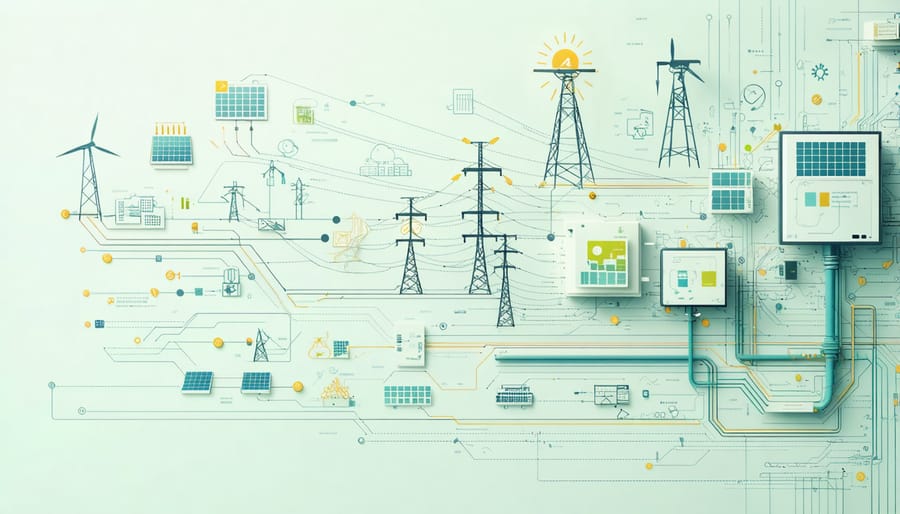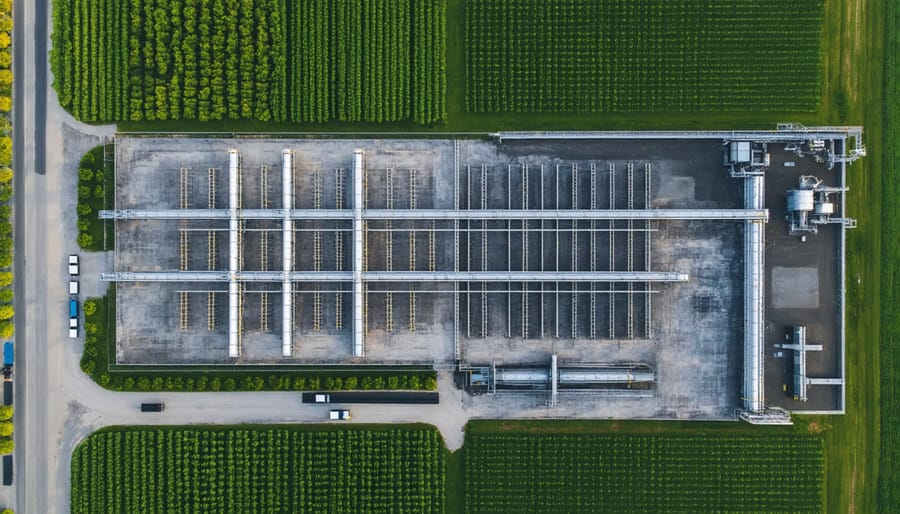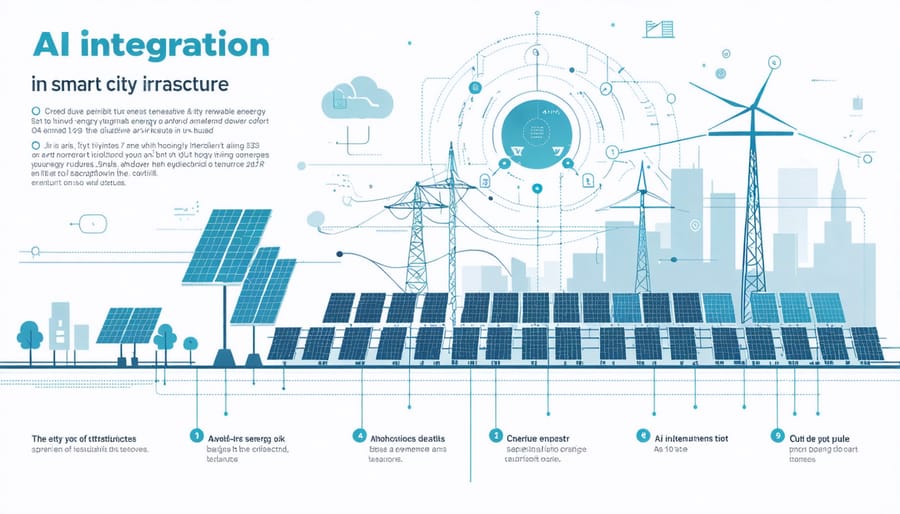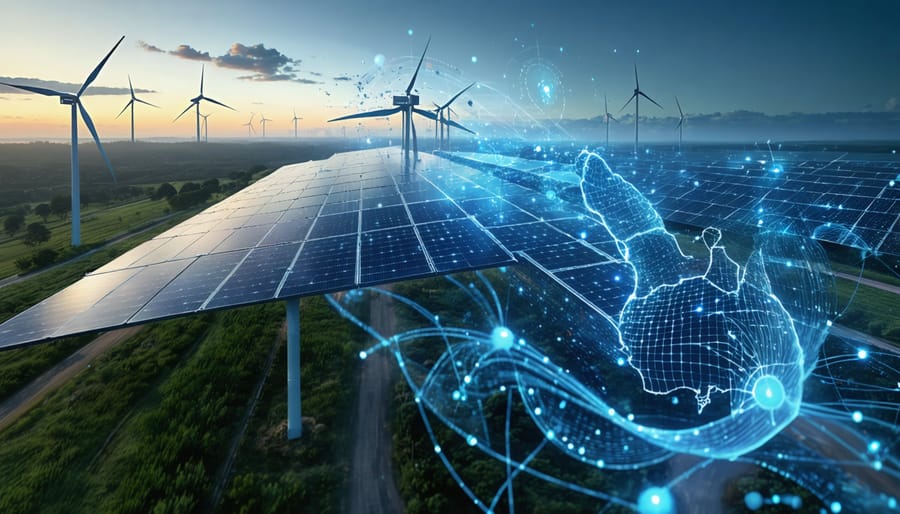Artificial intelligence is revolutionizing the renewable energy sector, driving unprecedented efficiency gains and accelerating our transition to a sustainable future. By harnessing machine learning algorithms and advanced data analytics, AI systems are transforming how we generate, distribute, and manage clean energy resources across Australia and beyond. From optimizing solar panel placement through satellite imagery analysis to predicting wind farm output with 90% accuracy, AI technologies are solving complex challenges that once seemed insurmountable in the renewable energy space.
This powerful convergence of AI and renewable energy isn’t just improving operational efficiency—it’s reshaping the entire energy landscape. Smart grids powered by AI can now balance power supply and demand in real-time, reducing waste and maximizing the use of available renewable resources. Predictive maintenance systems are cutting downtime at solar and wind facilities by up to 25%, while AI-driven energy storage solutions are ensuring reliable power supply even when the sun isn’t shining or the wind isn’t blowing.
For Australian businesses and communities, this technological revolution represents a crucial stepping stone toward achieving our ambitious clean energy targets while maintaining grid stability and reducing costs. The marriage of AI and renewable energy is proving that a sustainable future isn’t just possible—it’s profitable and increasingly within reach.
AI’s Game-Changing Role in Renewable Energy Systems
Smart Grid Management
Artificial Intelligence is revolutionizing how we manage and distribute renewable energy across Australia’s power grid. By analyzing vast amounts of data from weather patterns, consumption habits, and energy storage breakthroughs, AI systems can predict and optimize energy distribution with unprecedented accuracy.
Smart grid management powered by AI enables real-time load balancing, automatically adjusting power distribution based on demand fluctuations. This is particularly crucial for integrating intermittent renewable sources like utility-scale solar implementation and wind farms into the existing grid infrastructure.
In Queensland, for instance, AI-driven smart grids have reduced energy wastage by 15% while improving the reliability of renewable power delivery. The system anticipates peak demand periods and automatically redirects excess power to storage facilities or areas with higher consumption needs. This intelligent management ensures that clean energy is available when and where it’s needed most, making renewable sources increasingly reliable for both residential and industrial users.

Predictive Maintenance and Performance
Artificial intelligence is revolutionizing how we maintain and optimize renewable energy systems across Australia. By analyzing vast amounts of real-time data from wind turbines, solar panels, and other renewable infrastructure, AI algorithms can predict potential equipment failures before they occur, significantly reducing downtime and maintenance costs.
In Queensland’s solar farms, smart AI systems monitor panel performance and automatically adjust cleaning schedules based on weather patterns and dust accumulation. These systems have improved energy output by up to 15% while reducing maintenance expenses by nearly 25%.
Machine learning algorithms also optimize performance by analyzing weather forecasts, historical data, and current operating conditions. For instance, wind farms in South Australia use AI to adjust turbine blade angles in real-time, maximizing energy capture while minimizing wear and tear on equipment.
The integration of AI-powered drones for infrastructure inspection has been a game-changer. These autonomous systems can quickly survey large renewable installations, using thermal imaging and pattern recognition to identify potential issues that human inspectors might miss. This proactive approach to maintenance has helped renewable energy operators achieve record-breaking reliability rates while keeping operational costs down.
AI-Powered Bioenergy Solutions
Biomass Resource Management
In the heart of Australia’s agricultural regions, AI systems are revolutionizing how we manage biomass resources, turning agricultural waste into valuable renewable energy. Smart algorithms now analyze satellite imagery and weather data to predict optimal harvesting times for crop residues and forestry waste, ensuring maximum energy yield while maintaining ecological balance.
These AI-powered systems create detailed collection routes that minimize fuel consumption and reduce operational costs by up to 30%. In Queensland’s sugarcane fields, for instance, automated systems track bagasse availability and quality, directing collection vehicles to the most profitable locations while considering factors like moisture content and energy potential.
Machine learning algorithms are also transforming biomass processing facilities. By continuously monitoring and adjusting processing parameters, these systems optimize conversion efficiency and reduce waste. The Western Australian Biomass Processing Centre has reported a 25% increase in biogas production since implementing AI-controlled digesters that automatically adjust temperature, pH levels, and feeding rates.
Real-time monitoring through IoT sensors, coupled with AI analysis, helps facility operators predict maintenance needs and prevent costly breakdowns. This predictive maintenance approach has proven particularly valuable in remote processing plants where technical support isn’t readily available.
Looking ahead, emerging AI applications are focusing on creating digital twins of biomass facilities, allowing operators to simulate and optimize operations before implementing changes in the real world. These innovations are helping Australia’s bioenergy sector become more efficient and competitive, contributing to our renewable energy targets while creating value from agricultural waste.
The integration of AI in biomass management demonstrates how smart technology can help create a more sustainable and profitable renewable energy sector, turning what was once considered waste into a valuable energy resource.

Efficiency Optimization
Artificial intelligence is revolutionizing how we harness and optimize bioenergy, bringing unprecedented efficiency to conversion processes and resource utilization. In Australia, where biomass resources are abundant, AI systems are helping transform agricultural waste and organic materials into clean, renewable energy with remarkable precision.
Smart algorithms are now capable of analyzing feedstock composition in real-time, adjusting processing parameters to maximize energy output while minimizing waste. For instance, at the Richgro Bioenergy Plant in Western Australia, AI-powered sensors continuously monitor moisture content, temperature, and chemical composition, ensuring optimal conditions for biogas production. This intelligent monitoring has increased energy yield by up to 25% compared to traditional methods.
Machine learning models are also revolutionizing supply chain management for bioenergy facilities. These systems predict biomass availability, optimize collection routes, and schedule deliveries to ensure a steady supply of feedstock while reducing transportation costs and emissions. The Mount Gambier Timber Industry is using AI to convert wood waste into bioenergy, with smart systems determining the most efficient processing methods based on wood type and moisture content.
Predictive maintenance powered by AI has become a game-changer for bioenergy facilities. By analyzing equipment performance data, these systems can forecast potential failures before they occur, reducing downtime and maintenance costs. Some facilities report up to 40% reduction in unexpected shutdowns since implementing AI-based maintenance programs.
Looking ahead, emerging AI applications are focusing on developing more efficient bacterial strains for biogas production and optimizing enzymatic processes in biofuel creation. These advancements promise to make bioenergy an increasingly viable and cost-effective renewable energy source for Australia’s sustainable future.
Real-World Success Stories
Agricultural Waste to Energy
In the heart of Queensland’s agricultural belt, a groundbreaking initiative is transforming farm waste into renewable energy using AI-powered optimization. The Bundaberg Bioenergy Project has revolutionized how agricultural waste is processed, converting sugar cane bagasse, macadamia shells, and other farm residues into clean energy.
The facility employs sophisticated AI algorithms to analyze waste composition in real-time, automatically adjusting processing parameters for maximum energy yield. This smart system has increased energy production efficiency by 35% compared to traditional biomass conversion methods, while reducing operational costs by 28%.
What makes this success story particularly remarkable is the AI’s ability to predict and manage seasonal variations in waste supply. During the sugar cane harvest season, the system automatically recalibrates to handle increased bagasse volumes, while seamlessly switching to alternative waste streams during off-peak periods.
The project now powers over 5,000 local homes and has created new revenue streams for farmers who previously paid to dispose of agricultural waste. The AI system also optimizes storage and transportation logistics, reducing carbon emissions from waste collection by 40%.
This innovation has caught the attention of other agricultural regions across Australia, with similar projects now being developed in Victoria and New South Wales. The success demonstrates how AI can transform agricultural waste from an environmental challenge into a valuable renewable energy resource, supporting both farmers and Australia’s clean energy goals.
Smart City Integration
Smart cities across Australia are increasingly leveraging AI to revolutionize their renewable energy infrastructure. Melbourne’s smart grid system exemplifies this integration, where AI algorithms continuously monitor and optimize energy distribution from large-scale renewable energy projects to meet real-time demand.
The system uses machine learning to predict energy consumption patterns based on factors like weather conditions, public events, and historical usage data. During peak solar production hours, AI automatically redirects excess power to storage facilities or energy-intensive operations, ensuring nothing goes to waste. When demand spikes, the system intelligently balances power draw from various renewable sources, including solar, wind, and battery storage.
Smart sensors throughout the city monitor everything from traffic patterns to building occupancy, allowing AI to make split-second decisions about energy distribution. For instance, street lighting automatically dims or brightens based on foot traffic, while building management systems adjust temperature controls according to occupancy patterns.
These urban renewable energy networks have shown impressive results, with some districts reporting up to 30% reduction in energy consumption. The success has inspired other Australian cities to adopt similar systems, creating a ripple effect of sustainable urban development. As these smart city initiatives continue to evolve, they’re proving that AI-managed renewable energy isn’t just a future concept – it’s already transforming our urban landscapes today.

Future Opportunities and Challenges
Emerging Technologies
The integration of artificial intelligence in renewable energy systems is ushering in a new era of efficiency and innovation. Machine learning algorithms are now being deployed to predict wind patterns with unprecedented accuracy, enabling wind farms to optimize their turbine positioning and power generation in real time. In Australia, several pioneering projects are combining AI with advanced renewable energy storage solutions to create intelligent micro-grids that can adapt to changing weather conditions and energy demands.
Smart solar forecasting systems powered by AI are revolutionizing solar farm operations, using computer vision and weather data to anticipate cloud cover and adjust panel positioning accordingly. These systems have shown impressive results, increasing energy yield by up to 20% in pilot projects across Queensland and South Australia.
Particularly exciting is the emergence of AI-driven predictive maintenance systems. These sophisticated tools can detect potential equipment failures before they occur, dramatically reducing downtime and maintenance costs. For instance, a Victorian wind farm recently implemented an AI system that successfully predicted turbine bearing failures two months in advance, saving hundreds of thousands in potential repair costs.
Deep learning algorithms are also being employed to balance grid loads and optimize energy distribution, ensuring that renewable power is delivered efficiently when and where it’s needed most. This technology is proving especially valuable in remote communities, where AI helps manage hybrid renewable systems to maintain consistent power supply while minimizing reliance on backup diesel generators.
Implementation Roadmap
Implementing AI in renewable energy systems requires a well-structured approach that organizations can follow to ensure successful adoption. The journey typically begins with a comprehensive audit of existing energy infrastructure and data collection systems. This initial assessment helps identify areas where AI can make the most significant impact.
The first practical step involves setting up robust data collection mechanisms. This includes installing smart meters, sensors, and monitoring systems across renewable energy installations. For solar farms, this might mean implementing weather monitoring stations and panel performance trackers. Wind farms require turbine performance sensors and wind pattern monitoring equipment.
Next, organizations should focus on developing or acquiring appropriate AI solutions. This often starts with pilot programs in specific areas, such as predictive maintenance or power output optimization. Success stories from Australian renewable energy projects show that starting small and scaling up gradually yields the best results.
Training staff is crucial for successful implementation. Teams need to understand both the technology and its applications. Many Australian organizations are partnering with technical institutions to develop specialized training programs for their workforce.
The final phase involves integration and optimization. This includes connecting AI systems with existing infrastructure, establishing feedback loops, and continuously refining algorithms based on performance data. Regular evaluation and adjustment of AI systems ensure they remain effective and adapt to changing conditions.
For best results, organizations should establish clear metrics for success and maintain open communication channels between technical teams and management throughout the implementation process.
The integration of artificial intelligence in renewable energy marks a pivotal moment in our journey towards a sustainable future. As we’ve explored throughout this article, AI’s capabilities are revolutionizing how we harness, distribute, and optimize clean energy resources across Australia and beyond. From enhancing solar panel efficiency to optimizing wind farm operations and improving grid management, AI is proving to be an indispensable tool in accelerating our transition to renewable energy.
The success stories we’ve witnessed in smart grid implementations and predictive maintenance systems demonstrate that AI isn’t just a future prospect – it’s already delivering tangible benefits today. However, to fully realize its potential, we need collaborative action from all stakeholders. Energy providers must embrace AI-driven solutions to improve their operations. Policymakers should create supportive frameworks that encourage AI adoption in the renewable sector. Researchers and technology developers must continue pushing the boundaries of what’s possible with AI in clean energy applications.
For individuals and organizations looking to contribute to this transformation, the time to act is now. Whether it’s supporting AI-enabled renewable energy projects, investing in smart energy solutions, or simply staying informed about these technological advancements, every action counts. Together, we can harness the power of AI to create a more sustainable and efficient energy future for Australia and set an example for the world to follow.
As we look ahead, the synergy between AI and renewable energy promises not just environmental benefits, but also economic opportunities and energy security for future generations. Let’s embrace this technological revolution and make it work for a cleaner, greener tomorrow.

